South Wales AGS Show, 2015
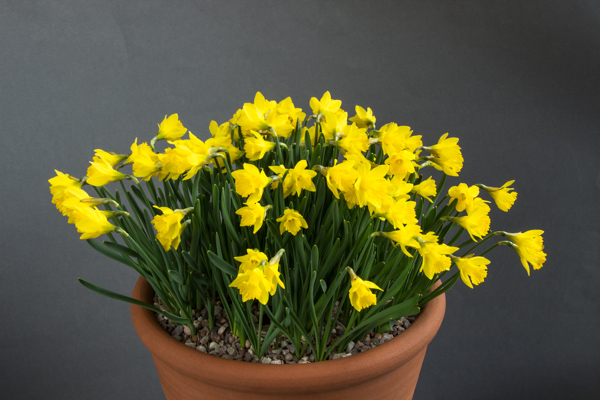
Without doubt, the show at Caerleon, held in mid-February and first in the almost weekly procession through to June, then again in the autumn, is my favourite of all. Not only is it an opportunity to see plants that peak too early to appear at the later shows: it also acts as a herald of spring and a sign that winter is nearing its end. Nearly 300 plants were on display, against the backdrop of a photographic display by Jon Evans (none of the images previously seen in public, and including a number of British natives, or adoptees, such as a spectacular colony of Gentiana clusii on the North Downs), which received a Gold Award. The show not only boasted quantity but also quality. That seven Certificates of Merit were awarded tells you something of the high standard that has been set for the coming show season.
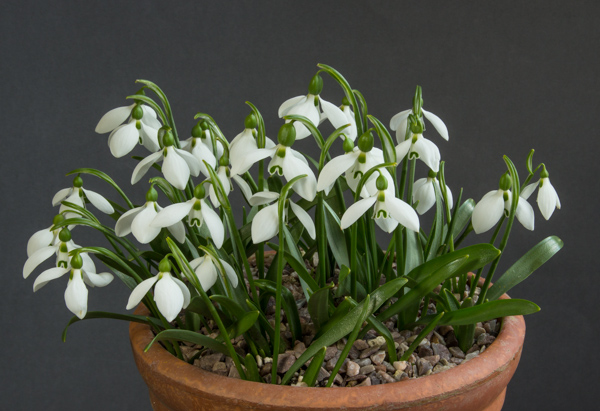
Given the date, it will come as no surprise to hear that bulbs were responsible for much of the colour on the benches. They also received most of the awards, with the Farrer Medal going to a superb pan of Narcissus asturiensis displayed by Eric Jarrett [above]. This was not his only success of the day: he was also the recipient of a Certificate of Merit for Benthamiella azorella and the Galanthus Goblet for Galanthus fosteri [left] ‒ one of the few occasions when this has gone to a species instead of one of the numerous cultivars, dozens of which were on display throughout the show.
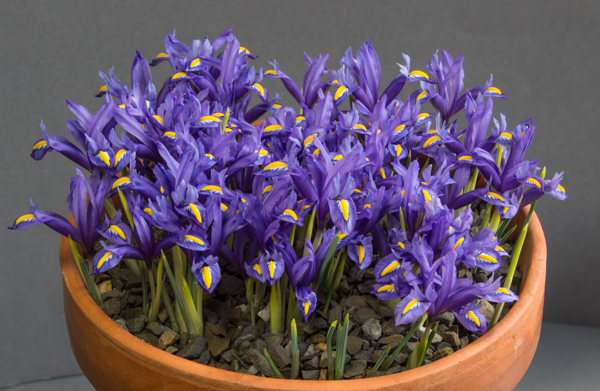
On the multiple awards front, Show Secretaries Bob and Rannveig Wallis collected enough firsts to retain the Isca Prize for most first prize points in the Open Section. A first in the small six-pan class contributed to this, as did Certificates of Merit for two of its components, Narcissus cantabricus and Iris hyrcana [right], along with a third for a pleasingly low-growing, vibrant Corydalis nariniana, the latter part of a three-pan entry of that genus.
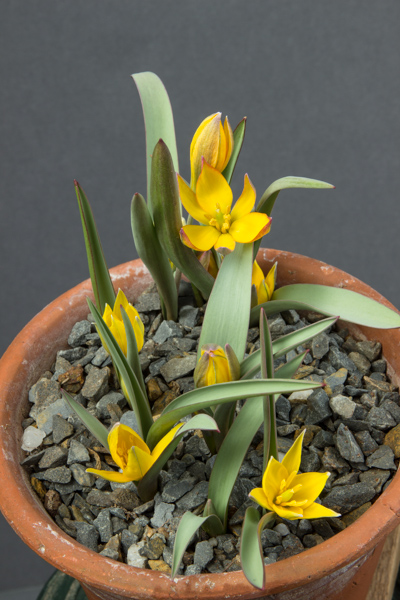
In the three-pan class for plants new or rare in cultivation they presented Tulipa koyuncui [left], an inhabitant of a few dry ridges in easternmost Turkey that was only described in 2010. Kept under glass in a mix of equal parts John Innes no. 2 and grit, the bulbs are given a dry summer. Its companions, Gymnospermum smirnovii from the western Caucasus, and a new species of Corydalis found in the Zaalay Mts of the Pamir range in Tajikistan, enjoy similar conditions.
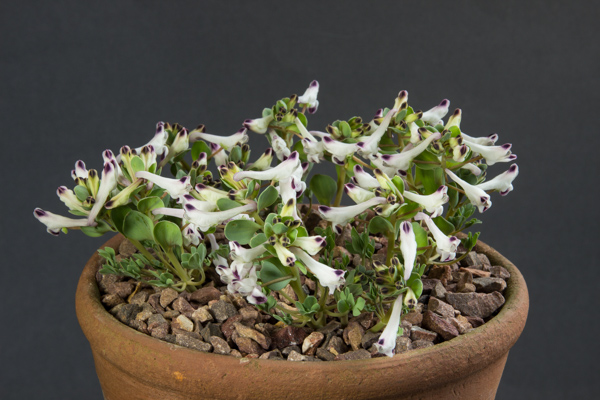
South Wales was certainly the place to be for Corydalis fans. From the very rare to the reasonably obtainable, George Elder exhibited a very handsome form of C. oppositifolia. He finds that, unlike other Section Leonticoides Corydalis, this particular form does not insist on appearing around the edges of the pot, so the cunning deployment of a plastic ring just above the tuber is not required. Kept under glass throughout the year in an equal mix of John Innes no. 3 and grit, after a dry summer watering resumes in November.
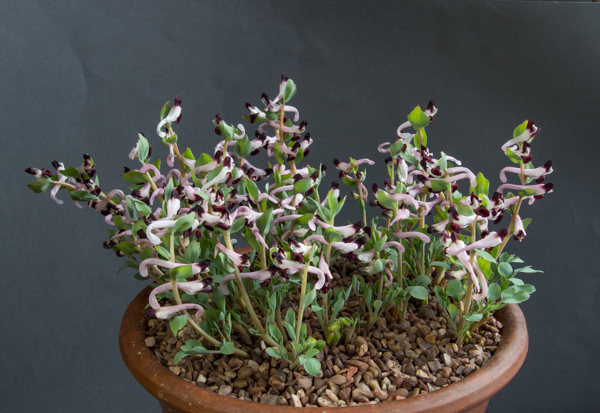
A further Corydalis that caught my eye was Robert Rolfe’s C. popovii. Another member of the same section, it can be found growing at not-impossible-walking-heights in screes throughout the Pamir-Alai. Its flowers, among the largest of the section, are a striking mix of pale pink to deep mauve. Just as with those Corydalis discussed above, a dry rest in the summer is essential.
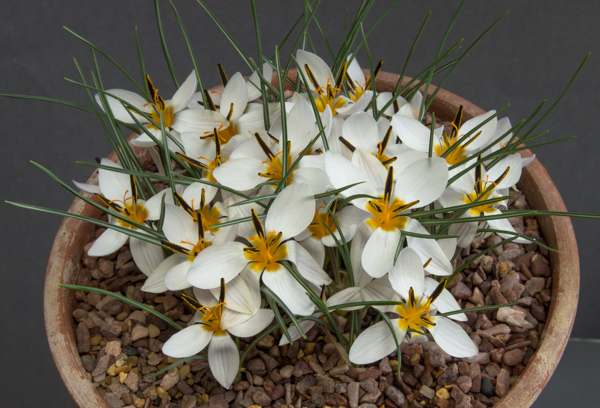
Robert was also responsible for another of the Certificates of Merit awarded at the show. In recent years there has been a surge in the number of Crocus biflorus subspecies (some now deemed species in their own rights) but what was labelled subsp. nubigena is the among the earliest flowering and arguably the most attractive. I first saw this at Caerleon a number of years ago: it remains my favourite member of the genus.
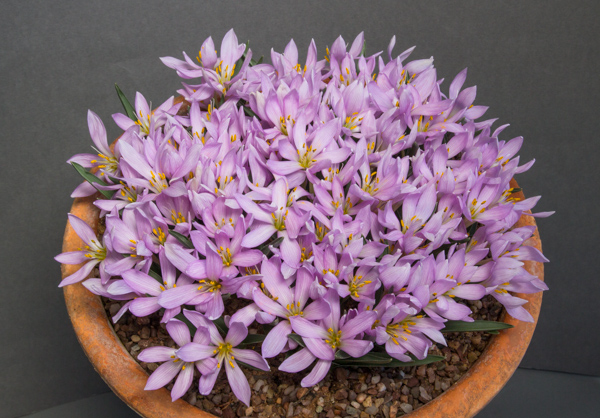
Another impressive Crocus was Jim McGregor’s C. etruscus, found in the woodlands of north-west Italy and easily grown either in the garden or, as with the pot shown, under cover. The sixth Certificate of Merit was awarded to his equally full pan of Colchicum hungaricum [left], an exhibit reminiscent of the flawless pan that earned Jim & Jenny Archibald the Farrer Medal at this show in 2010 (the McGregor example was runner-up in 2015).
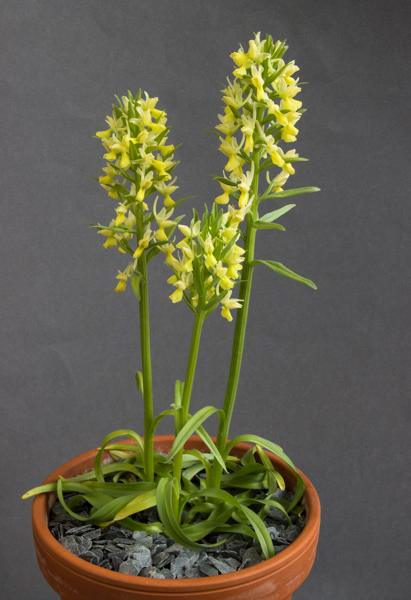
Turning briefly to non-flowering plants, in the Intermediate Section Pauline Carless had a fine example of the black grass, Ophiopogon plansicapus ‘Nigrescens’, complete with shiny black berries. This readily available plant is equally at home either in a pot or in the garden (it is currently thriving in a semi-shaded spot near a pond in my Bedfordshire garden).
The last of the Certificates of Merit went to Barry Tattersall’s elfin Muscari inconstrictum from Cyprus, a true dwarf as seen, but plants under the same name from further east can be more substantial. Barry also exhibited the primarily Mediterranean Dactylorhiza romana [right]. Earlier flowering than almost any other member of the genus, with pale yellow flower spikes on stems of around 30cm, it was one of the few orchids seen at Caerleon.
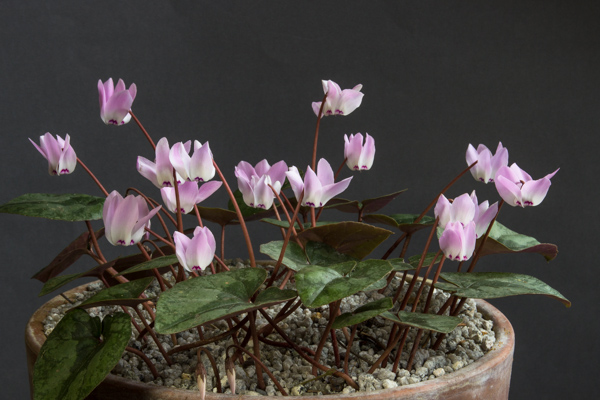
In comparison a second orchid at the show, Pleione humilis exhibited by Ian Robertson as part of his small six-pan entry, was anything but understated. Its brilliant red striped but otherwise pure white flowers were admired by many members of the public. Ian is renowned for the huge pans of Cyclamen he transports to this and other shows. This year, although not quite as numerous, he did not disappoint and one that stood out to me was C. libanoticum [left], a Lebanese native which has (in my experience) the undeserved reputation of being difficult to grow, though producing a well-flowered potful is a long-term project.
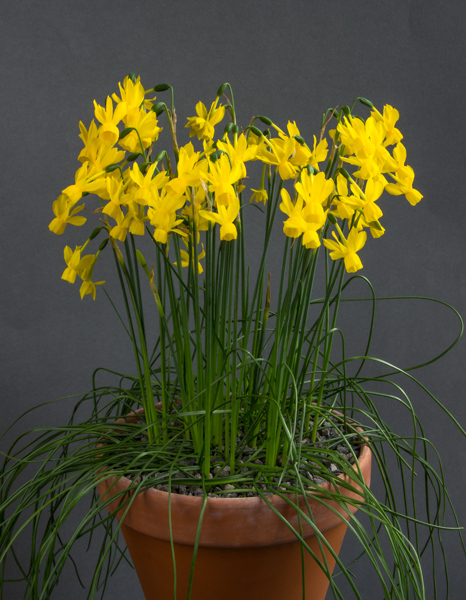
Had there been an eighth Certificate of Merit awarded at this show, it would have surely have gone to Narcissus ‘Dinah Rose’, a N. triandrus cross of unknown pollen parentage. Named for Dinah Rose Batterham, an accomplished plantswoman and gardener, it had been acquired by Lee & Julie Martin as a single bulb when Jim & Jenny Archibald’s bulb collection was dispersed in 2010. This has multiplied in a mix of two parts loam, two of grit, and one each of leaf-mould and perlite. That it also has one of the most pleasant scents of any Narcissus means this plant is now at the top of my ‘wish list’!
Possibly the rarest specimen at this year’s show was not a plant but a person. Carl Holmes was a first-time exhibitor and his success with Narcissus romieuxii will, it is to be hoped, encourage him join the ranks of seasoned showers in the future. This plant is from the mountains of Morocco and has proven hardy in some gardens. Personally, however, I prefer to keep it in a bulb frame, grown in a mix of equal parts John Innes no. 3 and perlite.
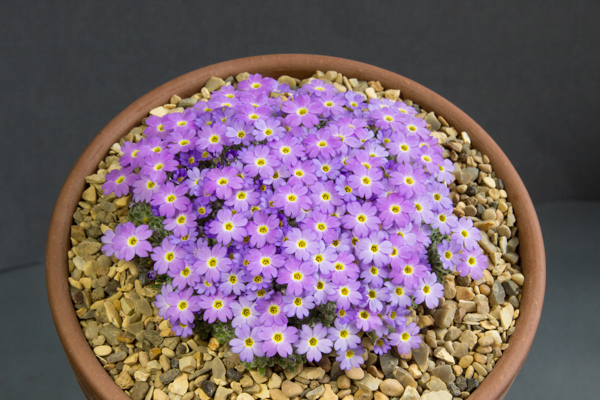
Last but by no means least, dionysias were also seen in both flowering and yet-to-flower guises. Paul & Gill Ranson’s D. archibaldii JLMS02-7/MK2, awarded the Ione Hecker Trophy for Best Pan of Primulaceae, was adjudged the best of these. Despite there being only the lightest of misty rains during staging, the Ransons brought their plants in under the protection of a plastic bowl – this sort of attention to detail being responsible for their success with this notoriously tricky genus.
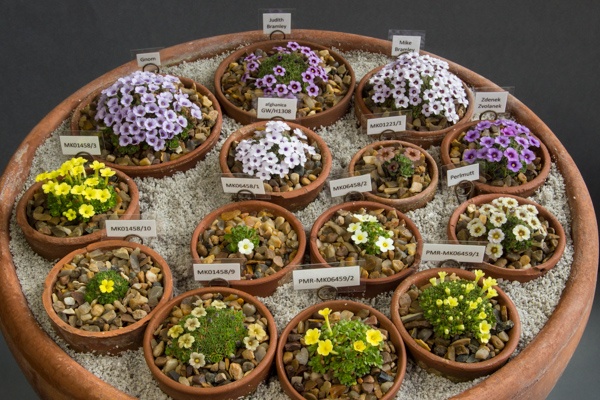
Arguably even more interesting was their fascinating non-competitive display of D. afghanica hybrids. Multiple small pots within a 30cm pan demonstrated the surprising colour range of cultivars raised from a species collected just once in 1971 in the wild, and at one time perilously close to lapsing from cultivation. Non-competitive sections should in my view become a feature of all AGS shows. The opportunity for highly skilled growers to use their imaginations and show off alpines in innovative ways could be a way to reinvigorate shows and another means for encouraging the public to join the Society. Food for thought as we look forward to what will no doubt be another fantastic season!
Author: Rob Amos
Photographer: Jon Evans
